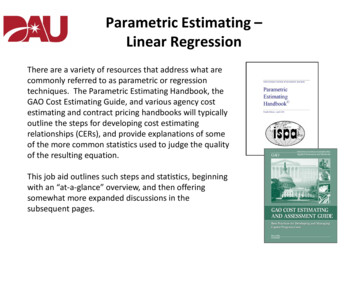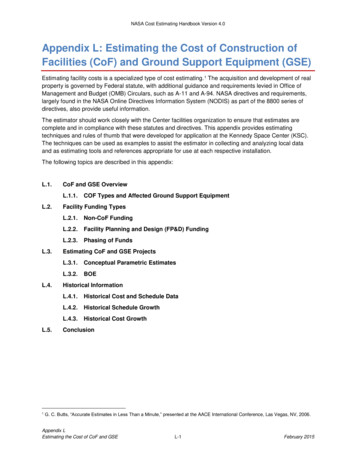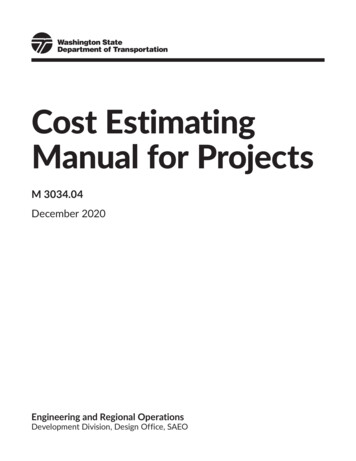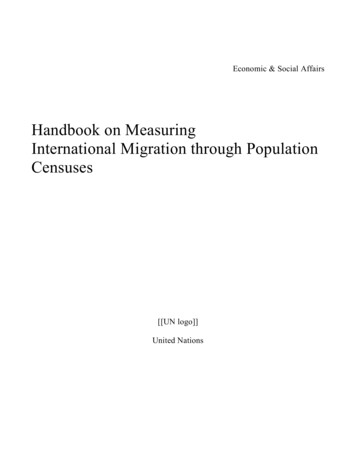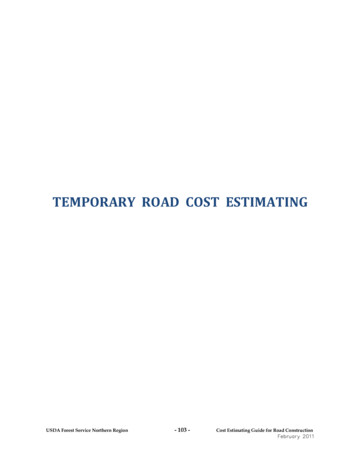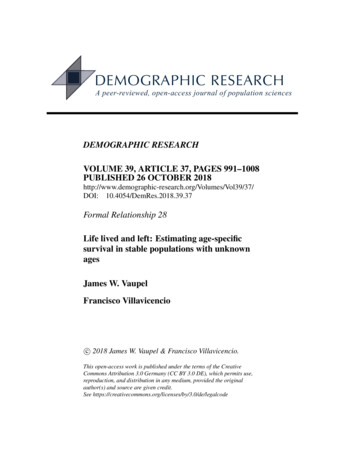
Transcription
DEMOGRAPHIC RESEARCHA peer-reviewed, open-access journal of population sciencesDEMOGRAPHIC RESEARCHVOLUME 39, ARTICLE 37, PAGES 991–1008PUBLISHED 26 OCTOBER l39/37/DOI: 10.4054/DemRes.2018.39.37Formal Relationship 28Life lived and left: Estimating age-specificsurvival in stable populations with unknownagesJames W. VaupelFrancisco Villavicencioc 2018 James W. Vaupel & Francisco Villavicencio.This open-access work is published under the terms of the CreativeCommons Attribution 3.0 Germany (CC BY 3.0 DE), which permits use,reproduction, and distribution in any medium, provided the originalauthor(s) and source are given credit.See alcode
Contents1Relationship9922Proof99233.13.23.3Related resultsThe stable population modelLife lived and left in stationary populationsThe population of France from a life left perspective99399499599744.14.2ApplicationLife lived and left in a discrete-time frameworkExample of application with simulated data997998100055.15.2The 1805 cohort life table of Swedish femalesEstimation of the growth rateReconstruction of the survival curve1002100310036Discussion1005References1006
Demographic Research: Volume 39, Article 37Formal Relationship 28Life lived and left: Estimating age-specific survival in stablepopulations with unknown agesJames W. Vaupel1Francisco Villavicencio2AbstractBACKGROUNDDemographers sometimes observe remaining lifespans in populations of individuals ofunknown age. Such populations may have an age structure that is approximately stable.To estimate life tables for these populations, it is useful to know the relationship betweenthe number of individuals at a given age a, and the number of individuals that are expectedto die a time units after observation. This result has already been described for stationarypopulations, but here we extend it to stable populations.RESULTSIn a stable population, the population at a given age a is a simple function of the number of deaths at remaining lifespan a, the number of deaths at remaining lifespans a andhigher, and the population growth rate. This property, which can be useful when agesare unknown, but individuals are followed until death, permits estimation of the underlying unknown survival schedule of the population and calculation of the usual life tablefunctions and statistics, including the stable age structure.CONTRIBUTIONThe main contribution of this article is to provide a formal proof of the relationship between life lived and life left in stable populations. We also discuss the challenges ofapplying theoretical relationships to empirical data, especially due to the fact that in realworld applications time is not continuous and some adjustments are necessary to movefrom a continuous to a discrete-time framework. Two applications, one with simulateddata and a second with Swedish data from the 19th century, illustrate these ideas.1 Interdisciplinary Center on Population Dynamics, University of Southern Denmark, Odense, Denmark.Email: jvaupel@sdu.dk.2 Interdisciplinary Center on Population Dynamics, University of Southern Denmark, Odense, Denmark.Email: c-research.org991
Vaupel & Villavicencio: Estimating age-specific survival in stable populations with unknown ages1. RelationshipConsider a stable population with constant growth rate r that is first observed at time t.Let N (a, t) be the unknown number of individuals in this population at any age a. Lete t) be the number of individuals in the population at time t who die a time units afterD(a,first observation. These are the individuals at time t who have exactly a time units of lifeleft. The term ‘life left’ pertains to the remaining lifetime untildeath, as opposed to ‘lifeRe (a, t) D(x,e t) dx: This functionlived’ or age of an individual or cohort.3 Let Nagives the number of individuals from the initial population who are still alive at time t a.Then, we have thate t) r Ne (a, t),N (a, t a) D(a,(1*)where N (a, t a) is the number of individuals at age a at time t a.4 Furthermore,given a population in which ages are unknown but individuals are followed until death,this result can be used to derive the underlying unknown cohort survival schedule, (a) (2*)e t) r Ne (a, t)D(a,N (a, t a) .e t) r Ne (0, t)N (0, t)D(0,2. ProofStable population theory implies thatZ Z raeD(x, t) B(t) ed(a x) da 0 B(t) e r(a x) d(a) da,xwhere B(t) are the births at time t and d(a x) is the unconditional risk of death at agea x. Applying the Leibniz rule for differentiation under the integral sign, we get Z MdB(t) ed(a) da limB(t) e r(a x) d(a) daM dx xxZ M B(t) d(x) lim rB(t) e r(a x) d(a) dadd eD(x, t) dxdxZ r(a x)M xe t), B(t) d(x) r D(x,3 Other terms such as ‘time-to-death,’ ‘remaining lifespan,’ ‘follow-up duration,’ or ‘residual life’ are alsofrequently used to refer to life left.4 All the main results not previously published are marked with an asterisk next to the equation number.992http://www.demographic-research.org
Demographic Research: Volume 39, Article 37and, rearranging terms,B(t) d(x) (3)d ee t).D(x, t) r D(x,dxR d(x) dx for all a 0, integrating both sides of (3) yieldsZ d ee t) dxt) r D(x,B(t) (a) D(x,dxaZ MZ d ee t) dxD(x, lim D(x, t) dx rM adxaee t) r Ne (a, t), t) D(a, lim D(MBecause (a) aM e t) r Ne (a, t). D(a,Since (a) is the probability of surviving from birth to age a and B(t) are the birthsat time t, it follows that B(t) (a) N (a, t a), the population at age a at time t a,which proves (1*). Equation (2*) follows directly from (1*) and the definition of thecohort survival function (a).3. Related resultsThe main result in (1*) that describes the relationship between life lived and life left instable populations has already been proved for the particular case of stationary populations with growth rate r 0 (Brouard 1989; Vaupel 2009; Villavicencio and Riffe 2016).To our knowledge, Vaupel was the first to generalize it to stable populations in an unpublished manuscript from 2013. Here we polish Vaupel’s proof and include some additionalmaterial.In the stable population model, the crude birth rate b and the crude death rate d areassumed to be constant over time, which permits estimation of the constant growth rate rof the population. Let N (t), B(t) and D(t) denote, respectively, the population size, thenumber of births, and the number of deaths at time t in a stable population. Then(4)r b d D(t)B(t) ,N (t) N (t)and(5)B(t) D(t) r N (t).Equation (5) can be re-expressed as follows: In stable populations, at any time tthe number of individuals with 0 life lived (births) equals the number of individuals withhttp://www.demographic-research.org993
Vaupel & Villavicencio: Estimating age-specific survival in stable populations with unknown ages0 life left (deaths), plus an extra term that only depends on the constant growth rateand the population size. Equation (1*) extends this relationship to estimate the numberof individuals at older ages when the ages are unknown but there is information aboutthe remaining time until death. In population biology, for instance, one may think ofa wild population that is captured at a certain time point, and then the deaths and thenumber of individuals that are still alive at each subsequent time point are recorded untilextinction. This information can be used to estimate the age-specific survival, providedthat the assumption of stability is not overly distorting and that it is possible to estimatethe population growth rate r.Equations (4) and (5) pertain to a population with an initial age of 0, but they can begeneralized to apply to a population with any initial age a. Then, at time t, B(t) would bethe number of individuals who are age a, D(t) the number of individuals who die at agea and older, and N (t) the number of individuals alive at age a and older. The growth rater also pertains to the population above age a, but in the stable model this r is the samefor the entire population. Hence, Equation (1*) can be viewed as a generalization of (5).Note that N (0, t 0) B(t) because the population at age 0 at time t equals the birthsat time t. Further, the individuals who at time t have 0 remaining lifetime are the deaths,e t) D(t). Finally, the individuals from the initial population at timeand therefore D(0,e (0, t) N (t). As a result, (5) leads to (1*)t who are still alive at t 0 are the same, so Nwhen a 0:e t) r Ne (0, t).B(t) D(t) r N (t) N (0, t) D(0,3.1 The stable population modelIn 1760 Leonhard Euler (1707–1783) was the first to formally describe the concept ofa stable population, defined as a population closed to migration experiencing fixed agespecific death rates, and births that vary in geometric progression for a prolonged periodof time (Euler 1970). Euler’s work remained rather unknown to the scientific community, and his ideas were published during subsequent decades and centuries by scholarswho independently rediscovered them. The development of a fully articulated theory ofstable populations was due to Alfred J. Lotka (1880–1949) in a series of more than 30articles and a book, Théorie analytique des associations biologiques. This book was firstpublished in two separate volumes in 1934 and 1939 and, surprisingly, not translated intoEnglish until 1998 (Lotka 1934, 1939, 1998).In stable populations, the population size at time t is given byZ Z N (t) N (a, t) da B(t) e ra (a) da00where B(t) e ra are the births at t a. This definition implies that the population at any994http://www.demographic-research.org
Demographic Research: Volume 39, Article 37given age at time t is N (a, t) e ra N (a, t a). Therefore, our basic result (1*) canalso be used to estimate the unknown age structure at initial time t,(6*)c(a, t) e t) r Ne (a, t)e ra N (a, t a)D(a,N (a, t) e ra.N (t)N (t)N (t)It may also be interesting to observe that (6*) is equivalent to a more common expression for the proportion of the population at age a in terms of the birth rate b,(7)c(a, t) b e ra (a),as stated by Lotka more than a century ago (Lotka 1907). Equation (7) implies that thepopulation structure does not depend on time because the birth rate b is constant. Here,we use the notation c(a, t) to highlight that we refer to the age structure at the time ofcapture when the follow-up of the population starts. But in stable populations, the periodage structure – as well as the cohort survival schedule – is constant over time, so onecould simply write c(a).5Although stability is an abstract mathematical concept resulting from the continuous operation of strong demographic assumptions over the long run, these restrictionshave turned out to be serviceable in many applications. Stable population theory hasbeen widely used in the study of human and nonhuman populations, especially when accurate data is incomplete or problematic, as discussed in the manual The Concept of aStable Population: Application to the Study of Populations of Countries with IncompleteDemographic Statistics (United Nations 1968). Even though perfect stability is rarelyobserved, this book argues that many populations around the world are ‘semi-stable’ or‘quasi-stable,’ and possess some of the properties of the stable population model. Semistable refers to populations that have an unchanging age structure, whereas quasi-stabledescribes populations in which fertility remains unchanged and mortality improves gradually.3.2 Life lived and left in stationary populationsIn stationary populations, in addition to fixed age-specific death rates and closure to migration, the birth flow is constant over time because of the growth rate r 0, whichimplies that, in the long run, the number of births equals the number of deaths and thepopulation size remains constant. This approach is more restrictive than stability but canlead to new insights about population dynamics. Some of these insights pertain to thesymmetries between life lived and life left. Kim and Aron (1989) – and later Goldstein5 For a general overview of the main properties of stable populations, see for instance Preston, Heuveline, andGuillot (2001, Chapter 7).http://www.demographic-research.org995
Vaupel & Villavicencio: Estimating age-specific survival in stable populations with unknown ages(2009) – proved that the average age of a stationary population equals average remaining life expectancy, whereas Riffe (2015) addressed the equivalence between the force ofmortality by age and the force of increment by life left. Moreover, stationary populationspresent a symmetry between their age composition and the distribution of remaining lifetimes. This relationship was first described by Brouard (1986, 1989), and was later independently formulated by James Carey and colleagues in the study of the survival patternsof captive and follow-up cohorts of medflies (Müller et al. 2004, 2007). Vaupel (2009)proved that in stationary populations of infinite size and in continuous time, the probability that a randomly selected individual is age a equals the probability that an individualhas exactly a time left until death. Villavicencio and Riffe (2016) suggested an alternativeproof for empirical and finite stationary populations in a discrete-time framework.An alternative perspective is to consider the births and deaths in stationary populations, which need to be continuously in balance to keep the population size constant.Hence, the number of individuals at age 0 (births) equals the number of individuals with0 life left (deaths). Note that the first group forms a birth cohort, whereas in the secondthere are individuals from different ages who share the same time of death, forming a‘death cohort.’ The key point is that this result is true for all ages when the populationis stationary, meaning that the number of individuals at any age a equals the number ofindividuals with a life left within the population. Figure 1 illustrates these ideas: Life leftis plotted in the negative horizontal axis to convey the notion of a ‘countdown.’Figure 1:Symmetries between the age composition and the distribution ofremaining lifetimes in stationary populationsagedistributiondistribution ofremaininglifetimes ω a2 a10life lefta1a2ωage / life livedNote: Parameter ω refers to the maximum observed lifespan.Equation (1*) extends this result to stable populations, so it can be used with lessrestrictive assumptions. In this case there is not an exact symmetry between life lived996http://www.demographic-research.org
Demographic Research: Volume 39, Article 37and left because of the growth rate r, but there is still a relationship between the agecomposition (captured by N (a, t)) and the distribution of remaining lifetimes (capturede t)). Note that if r 0, then N (a, t a) N (a, t) and (1*) becomesby D(a,e t).N (a, t) D(a,This equivalence formalizes the concept of symmetry between life lived and left in stationary populations that has just been described: The number of individuals aged a attime t equals the number of individuals who will die at time t a.3.3 The population of France from a life left perspectiveBrouard (1986) presents an original overview of the population dynamics of France in the20th century from a life left perspective. He compares the age structure of the French population in several years with what he calls the ‘pyramide des années à vivre,’ that is, theprojected structure of remaining lifetimes of the cohorts alive in those years. He also introduces the concept of ‘génération de décès’ (death cohort) mentioned above. Especiallyrelevant are the two pyramids from 1901, which show that the male population above age70 is surprisingly close to the population that at that time had more than 70 years of lifeleft and lived at least until 1970. Lower remaining lifetimes were caused by traumaticevents such as the two world wars that increased mortality, but in general there is a fairlyclose symmetry between both pyramids. In contrast, in the case of women the improvements in mortality were more marked, and thus the pyramid of remaining lifetimes hasmore individuals with higher values, given that more women lived longer than 70 yearsafter 1901 than those above age 70 in that year. Brouard concludes that the analysis ofthe remaining lifetimes offers a new interesting perspective for the study of populationdynamics, notably for older ages. He suggests the estimation of life left according tosome health markers, which could provide better insights into the characteristics of theold population and help in the assessment of proper policies.4. ApplicationDemographers like to think of time as a continuous process, which permits the use ofdifferential calculus and facilitates the proof of demographic relationships among demographic functions. This has been the case in the statement and proof of (1*) and (2*), aswell in the works mentioned above that are based on the stable population theory developed by Lotka (1939).In a theoretical population model, it is reasonable to assume time to be continuous, and compute vital rates and the instantaneous – although theoretical and potentiallyhttp://www.demographic-research.org997
Vaupel & Villavicencio: Estimating age-specific survival in stable populations with unknown agesnoninteger – number of births and deaths at any time. On the contrary, in an empiricalpopulation in which individuals are indivisible, the instantaneous number of births anddeaths would be zero, and the number of births and deaths would have to be computedin time intervals between observations. Villavicencio and Riffe (2016) adopted this approach to provide an alternative proof of the symmetries between life lived and left inempirical stationary populations. This approach represents a more realistic setup, but hasthe disadvantage of making the demonstration more complex than in the continuous case.4.1 Life lived and left in a discrete-time frameworkIn an empirical setup, some adjustments are necessary to adapt Equations (1*), (2*),and (6*) to a discrete-time framework. In general, we can only get the population countsat exact times t, t 1, t 2, etc., and we may not be able to know what births and deathsoccurred between observations. Moreover, a slightly different notation is usually adoptedto account for the fact that ages are not exact: In the following, we use subindices for theage variable to refer to the ‘age interval [a, a 1)’ instead of the ‘exact age a.’Suppose a population is first captured at time t and the total number of individualsN (t) is recorded. This same population is observed again at time t 1 and the numbere1 (t), the individuals from the initialof individuals still alive are recorded, obtaining Npopulation who are alive at time t 1, all of them at age 1 and above. The assumption ofstability implies(8)e1 (t),N1 (t) e r Nwhere N1 (t) is the unknown number of individuals that at exact time t were age 1 andabove. Equation (8) can be used to estimate the population at age [0, 1) at exact time t:N0 (t) N (t) N1 (t)e0 (t) e r Ne1 (t), Ne0 (t), the population at age 0 and above at exact time t. Analogously,given that N (t) Ne1 (t) N2 (t 1)N1 (t 1) Ne1 (t) e r Ne2 (t), Nwhere N1 (t 1) is the number of individuals at age [1, 2) at exact time t 1, N2 (t 1)e2 (t) is theis the number of individuals at age 2 and above at exact time t 1, and Nnumber of individuals from the initial population who are still alive at exact time t 2.This result can be extended to any age a, such that the population at age [a, a 1) at exact998http://www.demographic-research.org
Demographic Research: Volume 39, Article 37time t a isea (t) e r Nea 1 (t).Na (t a) N(9*)Equation (9*) is an extension of our basic result (1*) to the case of observationsmade not continuously but at points in time t, t 1, t 2, etc., and is valid for anytime unit – minutes, hours, days, years, or decades. It is necessary, though, that the sameunit is used to measure time and age, and that the population is observed at regular timepoints. The Lexis diagram in Figure 2 provides some intuition about these concepts andrelationships.Figure 2:Lexis diagram illustrating the relationship between life lived andlife left in a discrete-time frameworkN(t) N0(t)N1(t)e rN2(t)e r3age / life livedN2 (t 1)N2(t 2)N1 (t)e r2N1(t 1)e r1N0(t)0t 1tt 1t 2timee0 (t), Ne1 (t), Ne2 (t), etc. followingNote: Life lived is captured by N (t), N0 (t), N1 (t 1), etc., and life left by NEquation (9*).An equivalent expression to the survival schedule in (2*) for the discrete case followsimmediately from (9*),(10*) a ea (t) e r Nea 1 (t)Na (t a)N ,e0 (t) e r Ne1 (t)N0 (t)Nhttp://www.demographic-research.org999
Vaupel & Villavicencio: Estimating age-specific survival in stable populations with unknown agesand the stable age structure defined in (6*) becomesNa (t)e ra Na (t a) N (t)N (t)ea 1 (t)ea (t) e r NN e ra.N (t)ca (11*)Figure 3 illustrates these two last results in a Lexis diagram: By following a stablepopulation with unknown ages from time t onward, and recording at each subsequente0 (t), Ne1 (t), Ne2 (t), etc.), we aretime step the number of remaining individuals alive (Nable to recover the cohort survival schedule a (left panel) and the stable age structure ca(right panel).Figure 3:Lexis diagrams illustrating the cohort survival schedule a (leftpanel) and the stable age structure ca (right panel) that can beestimated by following a stable population until extinctionNote: Stable population with unknown ages that is followed from time t onward, recording at each subsequent timestep the number of remaining individuals alive, and applying (10*) and (11*).4.2 Example of application with simulated dataTo check the validity of our results, we proceed with a reproducible example based onsimulating a stable population. Following the same idea that James Carey and colleaguesdeveloped in the study of survival patterns of captive medflies (Müller et al. 2004, 2007),1000http://www.demographic-research.org
Demographic Research: Volume 39, Article 37we observe a population at regular time points until its extinction, and we record theea (t) values at each time step. Applying (9*), (10*), and (11*), we use these values toNestimate the survival schedule used in the data simulation and the corresponding stableage structure. The R code (R Core Team 2018) to carry out this experiment is availablein the supplementary materials; only a few details are provided below.We adapt the same simplified example of a stable population used by Preston, Heuveline, and Guillot (2001: 138–141), so the reader can refer to that book to find additionalexplanation. Suppose there is a hypothetical population in which all individuals die before age 5, defined by the following life table:Table 1:Life table (survival schedule) used in the data simulationa012345 a1.000.600.400.200.050.00Function a gives the probability of surviving from age [0, 1) to age [a, a 1).All cohorts are driven by this survival schedule. We start with an initial population ofN0 (t 5) 105 individuals at age [0, 1) at time t 5. At time t 4, N1 (t 4) N0 (t 5) 1 individuals will reach age [1, 2), and N0 (t 4) N0 (t 5) er newly bornwill join the population, since r is the constant growth rate. Following the same procedurefor older ages and assuming a growth rate of r 0.01, at time t the population becomesstable with a population size of 234,248 individuals. The population counts by age aredisplayed in Table 2.Table 2:Population counts by age at time t of a simulated stable populationwith constant growth rate r 0.01aNa (t)0N0 (t 5) e5r 0 105 e0.05 1.00 105, 1271N0 (t 5) e4r 1 105 e0.04 0.60 62, 4492N0 (t 5) e3r 2 105 e0.03 0.40 41, 2183N0 (t 5) e2r 3 105 e0.02 0.20 20, 4044N0 (t 5) er 4 105 e0.01 0.05 5, 050 105 0.005N0 (t 5) 5TotalN (t) 234, 248 individuals 0From this population of 234,248 individuals we draw 100 random samples of 1,000individuals each. Then, ignoring the ages, we follow all of these samples until extinction,ea (t) values).recording at each time step the number of individuals who are still alive (Nhttp://www.demographic-research.org1001
Vaupel & Villavicencio: Estimating age-specific survival in stable populations with unknown agesAt each iteration, individuals randomly die depending on the corresponding age-specificprobabilities of death. Applying (9*), (10*), and (11*), we get estimates for the survivalschedule and the stable age structure for all samples. Finally, combining the results fromthe 100 samples, we obtain mean values and empirical confidence intervals for all theestimates and compare them with the survival schedule used in the data simulation andthe age structure of the whole population. The results displayed in Table 3 show that ourmethod to estimate a and ca for stable populations may provide serviceably accurateresults. Differences among the estimates and the true values observed at the populationlevel are due to the randomness in the data simulation and the sampling process, and alsobecause of the rounding to integer values of the population counts. All true values fallwithin the 95% empirical confidence intervals of the estimates.Estimates of the cohort survival schedule ba and the age structurecba of a simulated stable population, using information on life leftTable 3:a012345True values at thepopulation level aca ba (10*)cba (11*)1.000.600.400.200.050.001.000000.60131 [0.52142, 0.68716]0.40345 [0.33590, 0.46453]0.20128 [0.15901, 0.25306]0.04807 [0.03019, 0.07151]0.000000.44847 [0.42200, 0.47662]0.26636 [0.24147, 0.28867]0.17700 [0.15225, 0.19604]0.08738 [0.07130, 0.10583]0.02066 [0.01295, 0.00000Estimates from the samplesNote: Estimates from 100 samples of size 1,000 that are randomly taken from a stable population of 234,248 individuals. The samples are followed until death. Values between square brackets represent 95% empirical confidenceintervals.5. The 1805 cohort life table of Swedish femalesAs an example of application with actual data, we aim to recover the 1805 cohort lifetable of Swedish females by applying Equations (9*) and (10*) to data on populationcounts. The goal is to create a scenario in which we simulate the ‘capture’ of the Swedishfemales in 1805, ignoring their ages, and follow this group of individuals until extinction.First, we ‘capture’ the population in 1805, as in a census. Next, we follow thoseindividuals along the 19th century by recording the number of individuals still alive atea (t) values. Finally, applying (9*) weeach subsequent five-year period, obtaining the Nuse these estimates to compute the number of individuals in each age group at each timeperiod (Na (t a) values, see Figure 2), in order to apply (10*) and estimate the survival schedule a of the 1805 cohort of Swedish females (Figure 3, left panel). All the1002http://www.demographic-research.org
Demographic Research: Volume 39, Article 37data comes from the Human Mortality Database (2018) (henceforth HMD). The resultspresented below are fully reproducible from the R code (R Core Team 2018) and dataavailable in the supplementary materials.5.1 Estimation of the growth rateAn estimate of the stable growth rate r is needed to apply the formulas in this article. Thisparameter can be estimated in various ways because all scalable stable population parameters grow exponentially at the same rate, including the number of births and deaths, andpopulation size. Keyfitz and Caswell (2005, Chapter 5.2) provide an interesting discussion about how to estimate the growth rate from a single census, given the assumption of astable population in which all cohorts follow the same life table. However, their approachrequires knowledge of the number of individuals at a minimum of two different ages, andthe probability of surviving between them. This is not the case in a context in which theages of the population are unknown, and the survival schedule is estimated depending onthe growth rate r, as shown in (2*) and (10*).If the number of births B(t) at first observation can be assessed, one could simplyconsidere t)B(t) D(t)B(t) D(0,.r e (0, t)N (t)NWhen that information is not available, r can be estimated if the entire population (ora random sample) is observed at two time points t1 and t2 so that information is availableon N (t1 ) and N (t2 ). This may be the most convenient approach in many real-worldscenarios. If that is the case, ln N (t2 ) ln N (t1 )(12)r ,t2 t1a formula that follows from the definition of a stable population (Keyfitz and Caswell2005: 12). We use (12) to estimate the growth rate of the Swedish female population inthe 19th century, using the total populations counts of 1805 and 1895 from the HMD: ln 2,509,076 ln 1,249,946ln N (1895) ln N (1805) 0.00774.r 1895 18051895 18055.2 Reconstruction of the survival curveGiven the estimate of the population growth, we can proceed as in the example of Section 4.2, but with actual population counts from the HMD. First, we get the total pope0 (1805) 1,249,946. Next, we specify the numberulation in 1805, N (1805) Nhttp://www.demographic-research.org1003
Vaupel & Villavicencio: Estimating age-specific survival in stable populations with unknown agesof individuals from that initial population who are still alive in 1810. In terms of theavailable data, this corresponds to the number of Swedish females above age 5 in 1810,e5 (1805) 1,105,919. We follow the same procedure to obtainN5 (1810) Ne10 (1805) 1,007,581, N15 (1820) Ne15 (1805), and so on. AllN10 (1815) Nthese populatio
3.2 Life lived and left in stationary populations 995 3.3 The population of France from a life left perspective 997 4 Application 997 4.1 Life lived and left in a discrete-time framework 998 4.2 Example of application with simulated data 1000 5 The 1805 cohort life table of Swedish females 100
